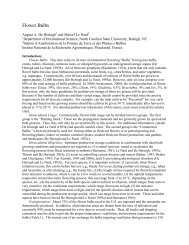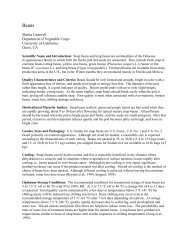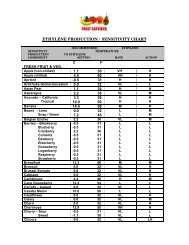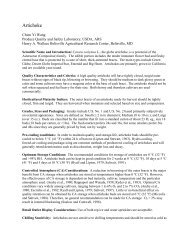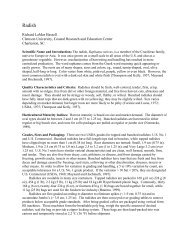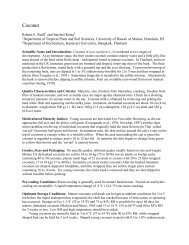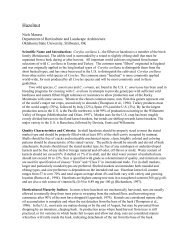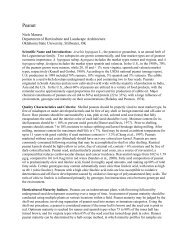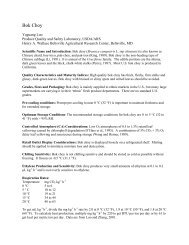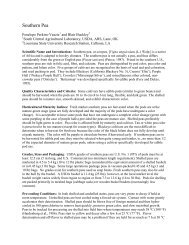Watercress
Watercress
Watercress
Create successful ePaper yourself
Turn your PDF publications into a flip-book with our unique Google optimized e-Paper software.
<strong>Watercress</strong><br />
Stephen Morris and Jenny Jobling<br />
Sydney Postharvest Laboratory, Food Science Australia<br />
North Ryde, NSW, Australia<br />
Specific Name and Introduction: <strong>Watercress</strong> (Nasturtium officinale R.Br.) has been known in Europe<br />
and Asia for thousands of years, and it is now grown in many countries worldwide. It is a member of the<br />
Brassicaceae (Cruciferae) family and is used as a leafy salad vegetable. It has attractive dark green<br />
leaves, a strong flavor and is rich in vitamins. <strong>Watercress</strong> is typically grown in running water (Snowden,<br />
1991).<br />
Horticultural Maturity Indices: Leaves should be harvested when full size and are still bright-green.<br />
Quality Characteristics and Criteria: <strong>Watercress</strong> should be bright-green and not limp. The leaves of<br />
watercress quickly become yellow and slimy when improperly handled.<br />
Grades, Sizes and Packaging: There are no U.S. Grade Standards. It is sold in bunches and can be<br />
packed in waxed cartons with top ice (Hruschka and Wang, 1979). It is also be packaged in boxes with<br />
plastic liners.<br />
Pre-Cooling Conditions: <strong>Watercress</strong> should be pre-cooled promptly after harvest either by hydrocooling<br />
or vacuum-cooling (Hruschka, and Wang, 1979).<br />
Optimum Storage Conditions: <strong>Watercress</strong> can be stored for 2 to 3 weeks at 0 °C (32 °F) with > 95%<br />
RH (Hruschka, and Wang, 1979). Shelf-life is reduced to 2 to 3 days if stored under low RH.<br />
Controlled Atmosphere (CA) Considerations: The rate of yellowing can be reduced by storing in<br />
atmospheres > 7% CO 2 with not less than 5% O 2 (Aharoni et al., 1989).<br />
Retail Outlet Display Considerations: Contact with melting ice and water sprays help in preventing<br />
dehydration. Handle carefully to avoid crushing or bruising the delicate leaves.<br />
Chilling Sensitivity: It is not sensitive to low temperature; store as cold as possible without freezing.<br />
Ethylene Production and Sensitivity: <strong>Watercress</strong> produces only low amounts of ethylene in response to<br />
wounding, < 0.1 µL kg -1 h -1 at 20 °C (68 °F). However, exposure to ethylene reduces shelf-life due to<br />
increased rate of yellowing (Philosoph-Hades et al., 1989).<br />
Respiration Rates:<br />
Temperature mg CO 2 kg -1 h -1<br />
0 °C 16 to 28<br />
5 °C 47 to 53<br />
10 °C 95 to 125<br />
15 °C 139 to 210<br />
20 °C 300 to 344<br />
25 °C 334 to 420<br />
To get mL kg -1 h -1 , divide the mg kg -1 h -1 rate by 2.0 at 0 °C (32 °F), 1.9 at 10 °C (50 °F), and 1.8 at 20 °C
(68 °F). To calculate heat production, multiply mg kg -1 h -1 by 220 to get BTU per ton per day or by 61 to<br />
get kcal per metric ton per day. Data are from Smith (1957) and Hruschka, and Wang (1979).<br />
Physiological Disorders: <strong>Watercress</strong> is very susceptible to dehydration and crushing of leaves.<br />
Postharvest Pathology: Harvested watercress is highly perishable. In warm conditions, the stems can<br />
become slimy as a result of bacterial soft rot due to Erwinia carotovora. It is therefore important that<br />
watercress is cooled promptly after harvest (Snowden, 1991).<br />
Quarantine Issues: None known.<br />
Suitability as Fresh-cut Product: It can be used as part of mixed salads.<br />
Special Considerations: Care must be taken to maintain high RH or storage-life is substantially<br />
shortened.<br />
References:<br />
Aharoni, N., A. Reuveni and O. Dvir. 1989. Modified atmospheres in film packages delay senescence and<br />
decay of fresh herbs. Acta Hort. 258:255-263.<br />
Hruschka, H.W. and C.Y. Wang. 1979. Storage and shelf-life of packaged watercress, parsley and mint.<br />
USDA Market Research Report No. 1102, 19 pp.<br />
Philosoph-Hades, S., E. Pesis, S. Meir, A. Reuveni and N. Aharoni. 1989. Ethylene-enhanced senescence<br />
of leafy vegetables. Acta Hort. 258:37-45.<br />
Smith, W.H. 1957. The production of carbon dioxide and metabolic heat by horticultural produce.<br />
Modern Refrig. 60:493-496.<br />
Snowden, A.L. 1991. A colour atlas of postharvest diseases and disorders of fruit and vegetables. Vol. 2,<br />
Vegetables. Wolfe Sci., Ltd., U.K., pp 219.



